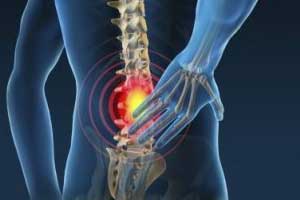- Home
- Editorial
- News
- Practice Guidelines
- Anesthesiology Guidelines
- Cancer Guidelines
- Cardiac Sciences Guidelines
- Critical Care Guidelines
- Dentistry Guidelines
- Dermatology Guidelines
- Diabetes and Endo Guidelines
- Diagnostics Guidelines
- ENT Guidelines
- Featured Practice Guidelines
- Gastroenterology Guidelines
- Geriatrics Guidelines
- Medicine Guidelines
- Nephrology Guidelines
- Neurosciences Guidelines
- Obs and Gynae Guidelines
- Ophthalmology Guidelines
- Orthopaedics Guidelines
- Paediatrics Guidelines
- Psychiatry Guidelines
- Pulmonology Guidelines
- Radiology Guidelines
- Surgery Guidelines
- Urology Guidelines
Can Chronic Back Pain be treated by brain stimulation ?

Researchers at the UNC School of Medicine have shown that they could target one brain region with a weak alternating current of electricity, enhance the naturally occurring brain rhythms of that region, and significantly decrease symptoms associated with chronic lower back pain. The results of the study have been published in the Journal of Pain.
Chronic pain is the leading cause of disability in the world and until now scientists have focused largely on peripheral causes of chronic pain. For example, if you have chronic lower back pain, then the cause and solution lie in the lower back and related parts of the nervous system in the spine.
Although there is no consensus among scientists that brain activity plays a causal role in the condition,the findings suggest that doctors could one-day target parts of the brain with new noninvasive treatment strategies, such as transcranial alternating current stimulation, or tACS, which researchers used in this study to boost the naturally occurring brain waves they theorized were important for the treatment of chronic pain.
“We’ve published numerous brain stimulation papers over several years, and we always learn something important,” said senior author Flavio Frohlich, PhD, director of the Carolina Center for Neurostimulation and associate professor of psychiatry. “But this is the first time we’ve studied chronic pain, and this is the only time all three elements of a study lined up perfectly. We successfully targeted a specific brain region, we enhanced or restored that region’s activity, and we correlated that enhancement with a significant decrease in symptoms.”Co-first author Julianna Prim, a graduate student mentored by Karen McCulloch, PT, PhD, in the Department of Allied Health Sciences at the UNC School of Medicine, who works closely with Frohlich’s lab, said, “If brain stimulation can help people with chronic pain, it would be a cheap, non-invasive therapy that could reduce the burden of opioids, which we all know can have severe side effects.”
Previous studies showed that people with chronic pain experience abnormal neural oscillations, or brain waves. There are several kinds of brain waves related to different brain regions and various kinds of brain activities – processing visual stimuli, memorization, creative thinking, etc. When we speak, think, eat, play sports, watch television, daydream, or sleep, our brain activity creates electrical patterns researchers can measure using electroencephalograms or EEGs. These patterns fluctuate or oscillate, which is why they appear as waves that rise and fall on an EEG printout.
One type of brain activity is called alpha oscillations, which occur when we are not taking in stimuli. When we meditate in silence, daydream in the shower, or even when we’re “in the zone” during athletic activity, alpha oscillations dominate the brain. The researchers feel that enhancing these electric oscillations may help treat people with medical conditions such as depression and chronic pain.
Prim and colleagues recruited 20 patients with lower chronic back pain. Each of them reported back pain as “four” or greater for at least six months on the subjective scale of one to 10. Each participant volunteered for two 40-minute sessions that took place one to three weeks apart.
During all sessions, researchers attached an array of electrodes to the scalps of patients. During one session, researchers targeted the somatosensory cortex using tACS to enhance the naturally occurring alpha waves. During another session for all participants, researchers used a similar weak electrical current that was not targeted – this was a sham or placebo stimulation session. During all sessions, participants felt tingling on their scalp. They could not tell the difference between the sham and tACS sessions. Also, the researchers in charge of analyzing the data did not know when each participant underwent the sham or tACS sessions, making this study double-blinded.
This study suggests that a rational design of transcranial alternating current stimulation, which is target identification, engagement, and validation, could be a nonpharmacological treatment approach for patients with CLBP.
For further reference log on to: DOI: https://doi.org/10.1016/j.jpain.2018.09.004

Disclaimer: This site is primarily intended for healthcare professionals. Any content/information on this website does not replace the advice of medical and/or health professionals and should not be construed as medical/diagnostic advice/endorsement or prescription. Use of this site is subject to our terms of use, privacy policy, advertisement policy. © 2020 Minerva Medical Treatment Pvt Ltd